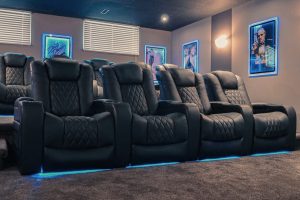Home theater seating is a pivotal element of the home entertainment experience. Over time, the design of home theater seating has evolved from traditional to modern, reflecting changes in aesthetics, functionality, comfort, and material choices.
Characteristics of Traditional Home Theater Seating
Design Style
Traditional home theater seating typically features classic, conservative design styles. These seats are often in darker tones, such as black or brown, and their appearance is closer to conventional furniture. They focus more on practicality than modern flair, often lacking in contemporary elements.
Materials and Quality
Traditional seats frequently use solid wood and high-density foam as their primary materials, ensuring durability and excellent support. However, these materials generally make the seats heavier and less movable.
Functional Features
In terms of functionality, traditional home theater seating usually offers basic reclining features. For instance, some seats might only have manual reclining capabilities, lacking modern features like electric adjustments.
Characteristics of Modern Home Theater Seating
Innovative Design
Modern home theater seating focuses more on fashion and personalization in design. The color choices are more varied, and the shapes and lines are sleeker and more contemporary. These seats often have more refined silhouettes, blending well with modern home decor.
Advanced Materials
Modern seats commonly use lightweight materials, such as synthetic leather or memory foam, which are not only lighter but also offer good wear resistance and are easy to clean. In terms of quality, modern materials provide equal or better comfort and durability compared to traditional seating.
Multifunctionality
Modern Home Theater Seating has a clear advantage in functionality. For example, many modern seats are equipped with electric adjustment features, built-in sound systems, USB charging ports, and even adjustable LED mood lighting. These features significantly enhance the viewing experience.

Performance and Cost Comparison
Power and Efficiency
Due to features like electric adjustments, modern seats might consume slightly more power than traditional seats, but they enhance overall efficiency and comfort.
Cost and Budget
In terms of cost, modern home theater seats are generally priced higher than traditional ones due to advanced materials and technology. However, many consumers find this a worthwhile investment for the additional features and increased comfort.
Size and Specifications
Modern home theater seats are designed with space efficiency in mind, so they are usually more compact compared to traditional seats, fitting well in limited spaces.
Conclusion
Traditional and modern home theater seating designs exhibit significant differences in design style, material choice, functionality, and cost. Modern seats, with their innovative designs, advanced materials, and multifunctionality, are attracting more consumers, while traditional seats appeal to those with a taste for classic design and practicality. The choice between the two depends entirely on individual needs and preferences.
